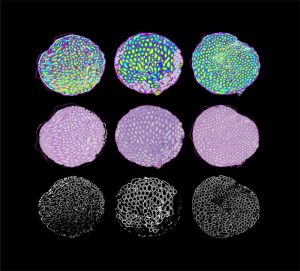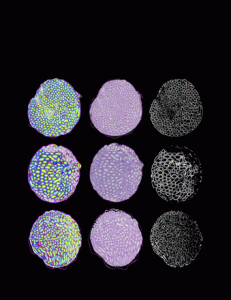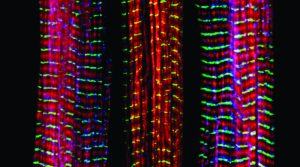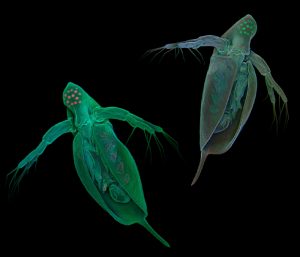Enter your address to receive notifications about new posts to your email.
Science & Publishing
-
Science & Publishing
Behind the cover: Male infertility in the mouse Collaborative Cross
Fascinating discoveries sometimes emerge from the most daunting of experimental roadblocks. Designed to generate over 1,000 recombinant inbred mice lines for genetic mapping, the Collaborative Cross (CC) project unearthed astounding variation in male fertility when nearly 95% of the highly inbred CC lines went extinct. As part of the Multiparental Populations series in the June…
-
Science & Publishing
New in G3: multiparental populations, worm fat levels, and mutant screen reports
Check out the June issue of G3! Table of Contents Editorial Back to the Future: Multiparent Populations Provide the Key to Unlocking the Genetic Basis of Complex Traits Dirk-Jan de Koning, Lauren M. McIntyre G3: Genes, Genomes, Genetics June 2017 7: 1617-1618; DOI: https://doi.org/10.1534/g3.117.042846 Commentary Epistasis: Searching for Interacting Genetic Variants Using Crosses Ian M.…
-
Science & Publishing
June GENETICS Highlights
Check out the June issue of GENETICS by looking at the highlights or the full table of contents! ISSUE HIGHLIGHTS Alternative polyadenylation directs tissue-specific miRNA targeting in Caenorhabditis elegans somatic tissues, pp. 757-774 Stephen M. Blazie, Heather C. Geissel, Henry Wilky, Rajan Joshi, Jason Newbern, and Marco Mangone Alternative polyadenylation (APA) is observed in virtually all metazoans and…
-
Science & Publishing
Dysfunctional calcium release contributes to muscle weakness as we age
Strong muscles aren’t important only for athletes—declining skeletal muscle strength is strongly associated with lower quality of life and even mortality in older adults. As the world’s population ages, understanding why muscle strength decreases over our lifespans is critical to ensuring seniors enjoy a happy, healthy old age. Normally, a muscle contracts when calcium is…
-
Science & Publishing
MPP People: Elizabeth King
Multiparental populations (MPPs) have brought a new era in mapping complex traits, as well as new analytical challenges. To face these challenges and encourage innovation, the GSA journals launched the ongoing Multiparental Populations series in 2014. This month’s issues of GENETICS and G3 feature a bumper 16 MPP articles, timed to celebrate a new easy-to-use…
-
Science & Publishing
Explore the new Multiparental Populations resource at GENETICS and G3
The GSA Journals are proud to announce a brand new site for our Multiparental Populations (MPP) series. We’re celebrating this redesigned, easy-to-browse site with the addition of sixteen new papers from both journals to the series. As the field of genetics has grown, the rapid development of genomic technologies has given researchers the ability to…
-
Science & Publishing
MPP People: Andrew Morgan
Multiparental populations (MPPs) have brought a new era in mapping complex traits, as well as new analytical challenges. To face these challenges and encourage innovation, the GSA journals launched the ongoing Multiparental Populations series in 2014. This month’s issues of GENETICS and G3 feature a bumper 16 MPP articles, timed to celebrate a new easy-to-use…
-
Science & Publishing
MPP People: Geoffrey Morris
Multiparental populations (MPPs) have brought a new era in mapping complex traits, as well as new analytical challenges. To face these challenges and encourage innovation, the GSA journals launched the ongoing Multiparental Populations series in 2014. This month’s issues of GENETICS and G3 feature a bumper 16 MPP articles, timed to celebrate a new easy-to-use…
-
Science & Publishing
Neural networks dive deep to locate proteins
As in real estate, so in cell biology: location is key. Knowing where a protein localizes in a cell gives insight into its function, and new research published in G3 describes a method to accurately identify a protein’s subcellular localization through high-throughput microscopy and machine learning. To determine a protein’s subcellular localization, researchers can tag…
-
Science & Publishing
On the cover: Daphnia in the spotlight
Illuminating the cover of the May issue of G3 is a lake-dwelling filter feeder no more than a couple millimeters long. This microcrustacean—Daphnia pulex, also known as the water flea—is an important model organism, especially in ecological genetics. But despite Daphnia’s status as a model organism, no one had examined its population genomics until now.…
-
Science & Publishing
Microbial DNA repair goes nuclear
In the ruins of the Chernobyl Nuclear Power Plant—an area deemed unsafe for humans for the next 20,000 years after a catastrophic failure—life thrives. Fungi that reside there, along with other organisms that can survive large radiation doses, must have strategies to cope with the DNA-damaging effects of living at a meltdown site. In the…











